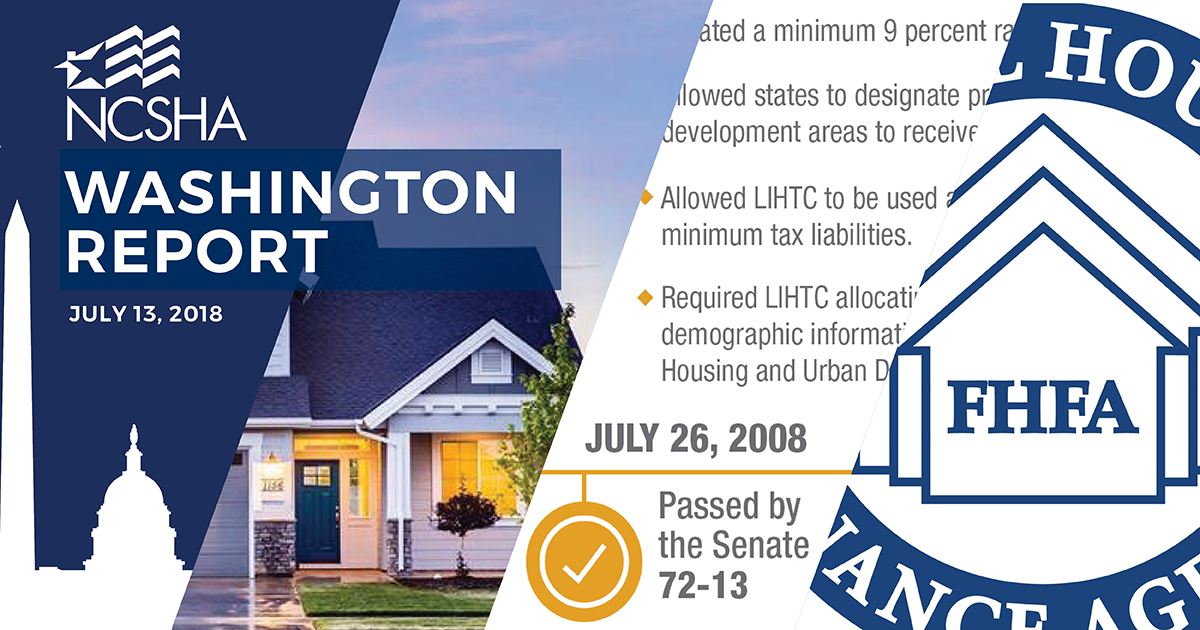Washington Report | July 13, 2018
 Almost exactly 10 years ago — on July 15, 2008 — Treasury Secretary Henry Paulson told the Senate Banking Committee: “If you’ve got a squirt gun in your pocket, you probably will have to take it out. If you have a bazooka in your pocket and people know it, you probably won’t have to take it out.”
Almost exactly 10 years ago — on July 15, 2008 — Treasury Secretary Henry Paulson told the Senate Banking Committee: “If you’ve got a squirt gun in your pocket, you probably will have to take it out. If you have a bazooka in your pocket and people know it, you probably won’t have to take it out.”
The metaphorical artillery Paulson was talking about, at a time when the housing market downturn was rapidly becoming a crash, was the authority the Bush administration was seeking to inject capital into Fannie Mae and Freddie Mac to maintain the solvency of the companies and the stability of the mortgage market. Paulson coined the phrase to suggest that the administration did not expect to do such a thing but having the authority would calm nervous investors.
A few weeks later, Congress passed the Housing and Economic Recovery Act of 2008 (HERA), which provided the authority Paulson sought and created a new GSE regulator, the Federal Housing Finance Agency. By September of that year, FHFA had placed Fannie and Freddie into conservatorship — and Treasury had entered into preferred stock purchase agreements with the companies.
HERA also authorized a temporary increase in Housing Credit authority and a raft of program improvements advocated by NCSHA and others — an advocacy campaign recounted as an oral history in the current issue of the Novogradac Journal of Tax Credits.
Other important HERA provisions included a temporary increase and some program improvements for housing bonds and creation of the Housing Trust Fund, Capital Magnet Fund, and the Neighborhood Stabilization Program — all of which HFAs have played a major role in implementing.
HERA’s most important provision for state HFAs, though, was its authorization of the Treasury Department to use Paulson’s bazooka.
HERA allowed Treasury to buy securities of Fannie- and Freddie-backed housing bonds. This became the basis for the Obama administration’s “HFA Initiative,” announced in October 2009. By then, every state HFA had “severely curtailed” their lending programs and some had suspended them, as NCSHA wrote in a letter to Treasury Secretary Timothy Geithner and HUD Secretary Shaun Donovan.
Using that HERA authority, NCSHA worked with the administration to create the New Issue Bond Program, through which Treasury purchased more than $15 billion in securities backed by state and local HFA housing bonds, and the Temporary Credit and Liquidity Program, which provided an additional $8 billion in liquidity for outstanding HFA housing bonds.
The initiative was a success: It enabled HFAs to finance more than 100,000 mortgages for first-time homebuyers and 24,000 units of affordable rental housing that otherwise would not have happened. And it ensured “the ability of the HFAs to maintain their important, Congressionally-supported role in the housing market, providing access to affordable mortgage credit for low- and moderate-income Americans… and stability to the financial markets and promoting mortgage affordability, while at the same time  protecting the taxpayer,” according to a report from the Treasury Department.
protecting the taxpayer,” according to a report from the Treasury Department.
A squirt gun would not have sufficed.
Stockton Williams | Executive Director
In This Issue
- NCSHA Meets with FHA Commissioner Montgomery
- Annual Awards for Program Excellence Update
- White House Report Calls for Work Requirements in Housing and Other Programs
- House Passes Voucher Mobility Demonstration Bill
- Urban Institute Report Examines State of Millennial Homeownership Market
- Children’s HealthWatch Finds Unstable Housing Leads to Avoidable Health and Education Costs
- Looking Ahead
NCSHA Meets with FHA Commissioner Montgomery
This week, NCSHA’s Stockton Williams and Garth Rieman met with recently confirmed and sworn-in Federal Housing Administration (FHA) Commissioner Brian Montgomery and his senior staff to discuss NCSHA’s priorities, particularly the Performance-Based Contract Administration procurement, the FHA-HFA Risk-Sharing program and its Federal Financing Bank option, and FHA single-family down payment assistance policies. Commissioner Montgomery described his positive view of and experience with state HFAs. He encouraged us to continue to bring forward the data and analysis that demonstrate HFA results and value-add in the housing market.
Annual Awards for Program Excellence Update
NCSHA received 131 entries from 40 HFAs in the 2018 Annual Awards for Program Excellence, an 11 percent increase in submissions over 2017. On July 10, 64 jurors — including representatives from housing associations, federal agencies, and affordable housing consultancies — assembled in Washington to review the entries and select the award recipients. Winners will be announced and awards presented during NCSHA’s 2018 Annual Conference & Showplace, October 13 – 16 in Austin.
Our thanks to all the HFAs that entered their programs, projects, and practices and to the jurors who participated in this important initiative to facilitate information-sharing among HFAs and to help NCSHA identify industry best practices and innovations. We encourage you to check out all the entries: They are accessible now on NCSHA’s website and many will be featured in presentations during the conference.
White House Report Calls for Work Requirements in Housing and Other Programs
The White House Council of Economic Advisors released on July 12 a report, “Expanding Work Requirements in Non-Cash Welfare Programs,” that discusses expanding work requirements in non-cash welfare programs, including housing programs, as a means of solving “the problem of non-disabled working-age recipients on non-cash welfare programs who work few, if any, hours.” The report says self-sufficiency has been declining in recent decades while material hardship has fallen, an alternative solution of increasing positive incentives for work (for example, by increasing the Earned Income Tax Credit) could exacerbate already-high implicit taxes on low-skill part-time workers, and evidence suggests welfare programs that require work in return for benefits increase adult employment and may improve children’s outcomes. The report notes that, “even if work requirements improve outcomes for the majority of affected recipients, some may experience negative effects, which is why it is important to design requirements carefully and to support recipients overcoming barriers to employment (e.g., lack of access to childcare, mental illness, or criminal records). The report concludes that, “Ultimately, expanded work requirements can improve the lives of current welfare recipients and at the same time respect the importance and dignity of work.”
House Passes Voucher Mobility Demonstration Bill
On July 10, the House of Representatives passed the Housing Choice Voucher Mobility Demonstration Act of 2018 (H.R. 5793), which authorizes HUD to carry out a Housing Choice Voucher mobility demonstration to encourage voucher recipients to move to lower poverty areas and expand access to opportunity areas. The bill, which was introduced by House Financial Services Housing and Insurance Subcommittee Chairman Sean Duffy (R-WI) and Ranking Member Emanuel Cleaver (D-MO), authorizes HUD to administer the mobility demonstration through a consortia of Public Housing Agencies (PHAs) that serve areas with high concentrations of housing voucher recipients in “poor, low-opportunity neighborhoods” and have enough moderately priced units in “higher opportunity areas” to meet the need. HUD would select participants based on competitive criteria. Interested PHAs would be required to submit a Regional Housing Mobility Plan that would identify the number of PHAs participating, the number of vouchers each PHA would make available for the demonstration, actions planned to accomplish the program goals, and criteria to identify opportunity areas. For more information, see NCSHA’s blog on the bill here.
Urban Institute Report Examines State of Millennial Homeownership Market
A new report from the Urban Institute’s Housing Finance Policy Center finds homeownership among millennials (those born between 1981 and 1997) continues to lag behind both Generation X and Baby Boomers. In 2015, the homeownership rate for millennials was 37 percent, 8 percent lower than it was for the previous two generations when they were at the same age range (25–34). The report finds that millennials’ tendency to delay marriage has had the biggest impact on their homeownership rate, followed by the increasing diversity of the millennial generation (since racial and ethnic minorities have historically had lower homeownership rates), increased student loan debt, and some millennials’ preferences to live in high-cost city centers. The report recommends increasing financial education, including information on down payment assistance programs offered by HFAs; using technology to streamline the mortgage application process; expanding credit scoring criteria to include an applicant’s history of rental and utility payments; and adjusting zoning codes to allow for the construction of more affordable single-family homes as ways to increase millennial generation homeownership. Urban also published a blog summarizing the report’s findings.
Children’s HealthWatch Finds Unstable Housing Leads to Avoidable Health and Education Costs
Children’s HealthWatch, a nonpartisan network of pediatricians, public health researchers, and children’s health and policy experts, recently published a brief estimating that roughly 10.2 million children and their families living in unstable housing incurred $8 billion in avoidable health care and education costs in 2016. The organization defines having unstable housing as experiencing at least one of the following conditions in the previous year: inability to pay rent or mortgage on time, moving two or more times, or homelessness. Children’s HealthWatch suggests several policy recommendations to help increase the supply of stable homes, including expanding the Low Income Housing Tax Credit, increasing HOME Investment Partnerships program funding, investing in the National Housing Trust Fund, providing more resources to help families pay their rent, and directing some health care investments to affordable homes and stabilizing services for families.
NCSHA Events
- September 14 | Discounted Early Registration Deadline for the 2018 Annual Conference & Showplace
- October 13 – 16 | 2018 Annual Conference & Showplace | Austin, TX
Legislative and Regulatory Activity
- July 19 | Senate Banking Committee Nomination Hearing for Kathy Kraninger to become Director of the Bureau of Consumer Financial Protection
- July 24 | Senate Banking Committee Nomination Hearing for Michael Bright to become Ginnie Mae President
- August 3 | Comments due to NCSHA on HUD’s Disparate Impact Standard Final Rule
- August 7 | Application deadline for HUD Counseling Grant Program NOFA
- August 20 | Comments due to HUD on its Disparate Impact Standard Final Rule

